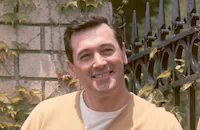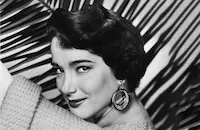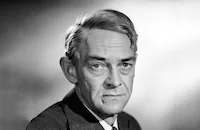The Lawless Breed
Brief Synopsis
Cast & Crew
Raoul Walsh
Rock Hudson
Julia Adams
Mary Castle
John Mcintire
Hugh O'brian
Film Details
Technical Specs

Synopsis
In 1896, John Wesley Hardin is released from a Texas prison after serving sixteen years of his sentence. His first act as a free man is to bring the manuscript of his life story to local publisher Henry Johnson. As Johnson reads the book, the story of Wes's life unfolds: At the end of the Civil War, Wes, a young gambler and sharpshooter, rebels against the abuse of his rigid preacher father, J. G. Hardin. Although Wes's sweetheart, Jane Brown, who is also being reared by J. G., urges him to be patient, Wes is anxious to make enough money to buy a cattle ranch. He leaves to make his fortune, starting out at the local saloon, where barmaid Rosie McCoy tries to engage his interest. Wes joins a poker game, but when he correctly accuses player Gus Hanley of cheating, Gus draws a gun and Wes shoots him in self-defense. Realizing that the Hanley brothers, Ike, Dirk and Ben, will soon be after him, Wes flees to his uncle John Clinton's house. John takes Wes along on as he herds cattle to Abilene, but Wes is recognized along the way and the Hanley brothers set chase. Before they can catch up to him, however, Wes reaches Abilene and wins a fast horse in a poker game. Determined to buy a wedding dress for Jane, he refuses to leave until he has won the money for the dress, even though everyone, including local marshal Wild Bill Hickok, insists that he leave town. With only seconds to spare before Hickok jails him, Wes wins the dress money and races away. When he arrives home, his father demands that he stand trial for Gus's murder. Although Wes is suspicious, J. G. promises to secure an excellent lawyer and marry him to Jane as soon as his name is cleared. Soon after, however, Ike pays local sheriff Charlie Webb to shoot Wes and claim that he resisted arrest. Charlie pulls his gun and shoots Wes in the shoulder, but Wes kills him. He runs home again but this time, neither J. G. nor Jane believes that he killed in self-defense. A posse gathers outside, and when Wes flees out the back door, Jane is killed as she runs after him. Wes is shot but escapes when John hides him under some brush. Later, Rosie and John return for him and nurse him back to health. Six years later, Wes is still on the run and being blamed for murders throughout Texas. The reactivated Texas Rangers have made tracking him down their top priority. Wes and Rosie flee the Rangers to a small farm in Alabama, where they assume the name of Swain. Rosie is unhappy there, worried that she can change but Wes never will, and that he will grow bored with her and farm life. To convince her of his devotion, Wes brings home a parson and marries Rosie. Soon after, she becomes pregnant and writes to J. G., who is secretly pleased at the thought of a grandson. Rosie admits to Wes that she was wrong about his ability to change, and that she feels safe with him. That day, however, Wes is caught in town by the Rangers. In Austin, he is found guilty of murdering Webb and sentenced to twenty-five years of hard labor. As he bids goodbye to his father, wife and new son, Wes continues to insist that he is not a murderer. In the present, Wes returns to the ranch, where Rosie, who has waited for him faithfully, embraces him joyously and sends him to the barn to meet his son, John. As John proudly spins his father's gun, horrific scenes of his own outlaw background flash before Wes's eyes. Like his own father, Wes snaps and hits his son, who runs off. Despondent, Wes explains to Rosie that he cannot let his son follow in his footsteps. He finds John in a saloon, about to enter a gunfight with a man who is insulting Wes. Wes discourages his son from shooting and escorts him to the door, but as they leave, the other man shoots Wes in the back. John holds Wes and promises his father he will not become a criminal. Later, Rosie and John take a recovered Wes home to his ranch.

Director

Raoul Walsh
Cast

Rock Hudson

Julia Adams

Mary Castle

John Mcintire
Hugh O'brian

Dennis Weaver
Forrest Lewis

Lee Van Cleef
Tom Fadden
Race Gentry
Richard Garland

Glenn Strange
William Pullen
Carl Pitti
Ned Davenport
Robert Anderson
Stephen Chase
Richard Wessel
Emory Parnell
I. Stanford Jolley
Tom Jackson
George Lynn
George Wallace

Roy Gordon
Edward Earle

Michael Ansara
Paul Newlan
John Pickard
Steve Darrell
Leo Curley
George Eldredge
Jeanne Gayle
Gertrude Graner
Paul Mcguire
Francis Ford
Kenneth Alton
Syl Lamont
Jean Andren
Charles Horvath
Cornelius Frizell
Ethan Laidlaw
Phil Tead
George Taylor
Wheaton Chambers
Dan Poore
Carl Harbaugh
Buddy Roosevelt
Frank Cordell
Stanley Blystone
Billy Vincent
Charles B. V. Miller
Crew
William Alland
William Alland
Leslie I. Carey
Al Cline
Hugh Cummings
Oliver Emert
William Fritzsche
Russell A. Gausman
Joseph Gershenson
Irving Glassberg
Bernard Gordon
Frank Gross
Bernard Herzbrun
William Holland
Dorothy Hughes
Corson Jowett
George Lollier
Rosemary Odell
Ed Plante
Richard Riedel
Joan St. Oegger
Dewey Starkey
Raoul Walsh
Bud Westmore

Film Details
Technical Specs

Quotes
John Wesley Hardin has made the name of Texas stick in the nostrils of justice.- Capt. W.H. McNally
What are you doing on the trail? Trying to pick up a little stray business?- John Clements
I pick up business any place I can find it. Business was good in Abilene. I had a special embalming and burying job on the Durango Kid. And if I do say so myself, when he was laid out, his own wife didn't even know him. She thought he was a stranger asleep in the parlor.- Chick Noonan
Trivia
Notes
The working titles of this film were Bad Man with a Gun and Gun Hand. The opening credit reads: "The Lawless Breed, based on the life of John Wesley Hardin as written by himself." Modern sources, however, add that the film was also based on Thomas Ripley's book They Died with Their Boots on (on the Life and Death of J. W. Hardin and Other Texas Desperadoes). The film opens with a written prologue that reads: "The 'Bad Men' of the West, the Jameses, the Daltons, the Ringos and the Youngers, are now part of American folklore. Research has added another name to the list-John Wesley Hardin. Hardin's story is unique because it was written by the man himself. This extraordinary testament, now a collector's item, was published in Seguin, Texas in 1896."
As depicted in the film, Hardin was born in 1853 in Texas and rebelled against the strict moralizing of his preacher father. In 1874, after killing several people, he shot Sheriff Charlie Webb. Although Webb's murder May have been the only one Hardin actually committed in self-defense, it was the only one for which he was jailed. Wild Bill Hickok, who briefly appears as a character in The Lawless Breed, became friends with Hardin in real life and is quoted as having said, "This is self defense, plain and simple. But I'll be damned if I've ever met anybody forced to do so much self-defending as that boy." Once out of prison, Hardin became a lawyer and then a sheriff. He lost his wife, Jane Bowen, and reared his son and daughter by himself. Hardened by Jane's death, he reportedly was a ruthless and murderous lawkeeper. In 1895 in El Paso, Hardin was shot repeatedly and killed by John Selman, Jr., a gunfighter.
The film was shot in Technicolor, but the flashback montage at the end of the story, when Hardin briefly recalls the events that led him to prison, are in black and white. Hollywood Reporter news items add the following members to the cast: William Reynolds, Guy Williams, Bobby Hoyt, John Maxwell and John Padiro. Neither Reynolds nor Williams were in the released film and the appearance of the other actors has not been confirmed. Some modern sources praise the film for its progressive attitude toward women and the ground-breaking ambiguity of its protagonist.

Miscellaneous Notes
Released in United States on Video June 9, 1998
Released in United States Winter January 1953
Released in United States Winter January 1953
Released in United States on Video June 9, 1998











